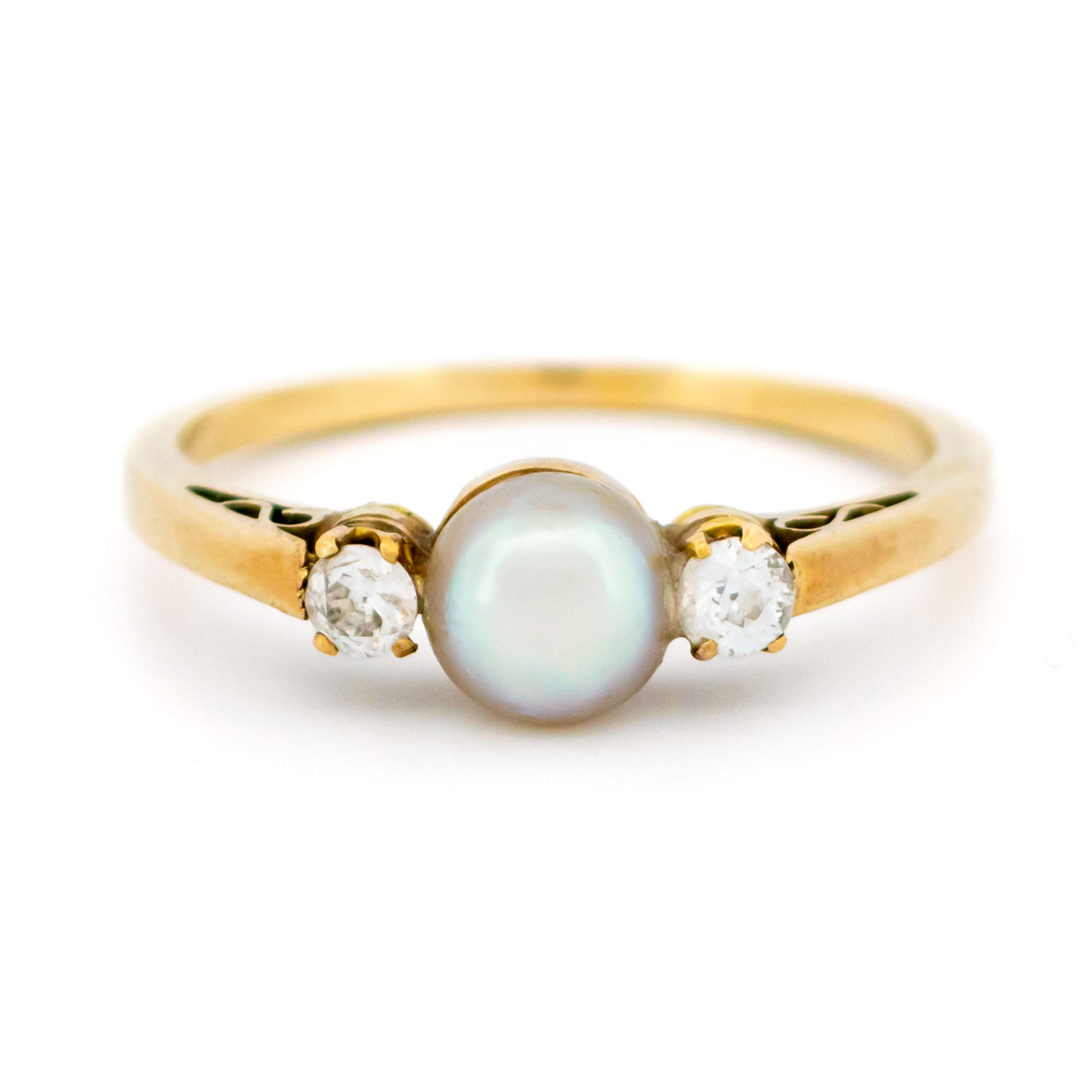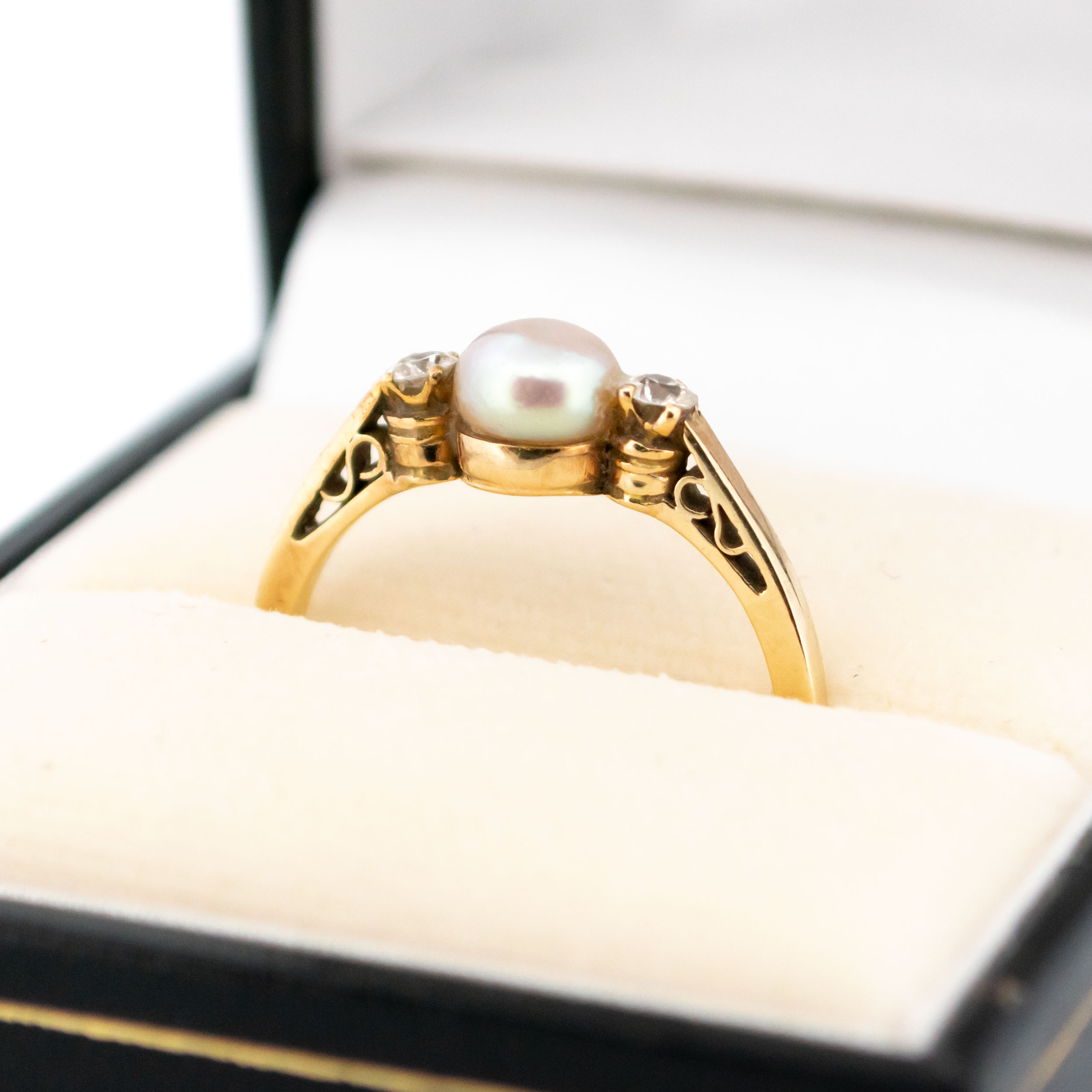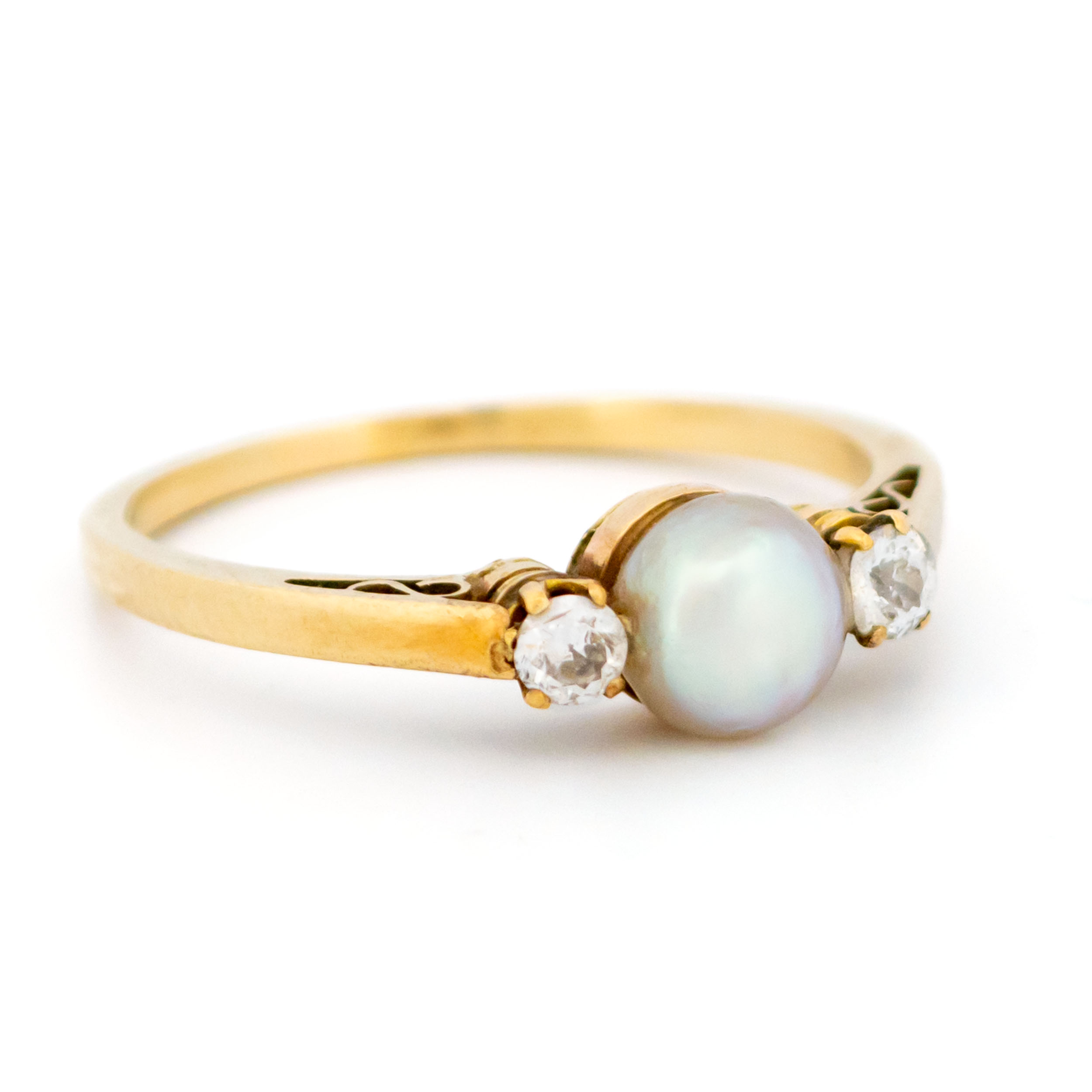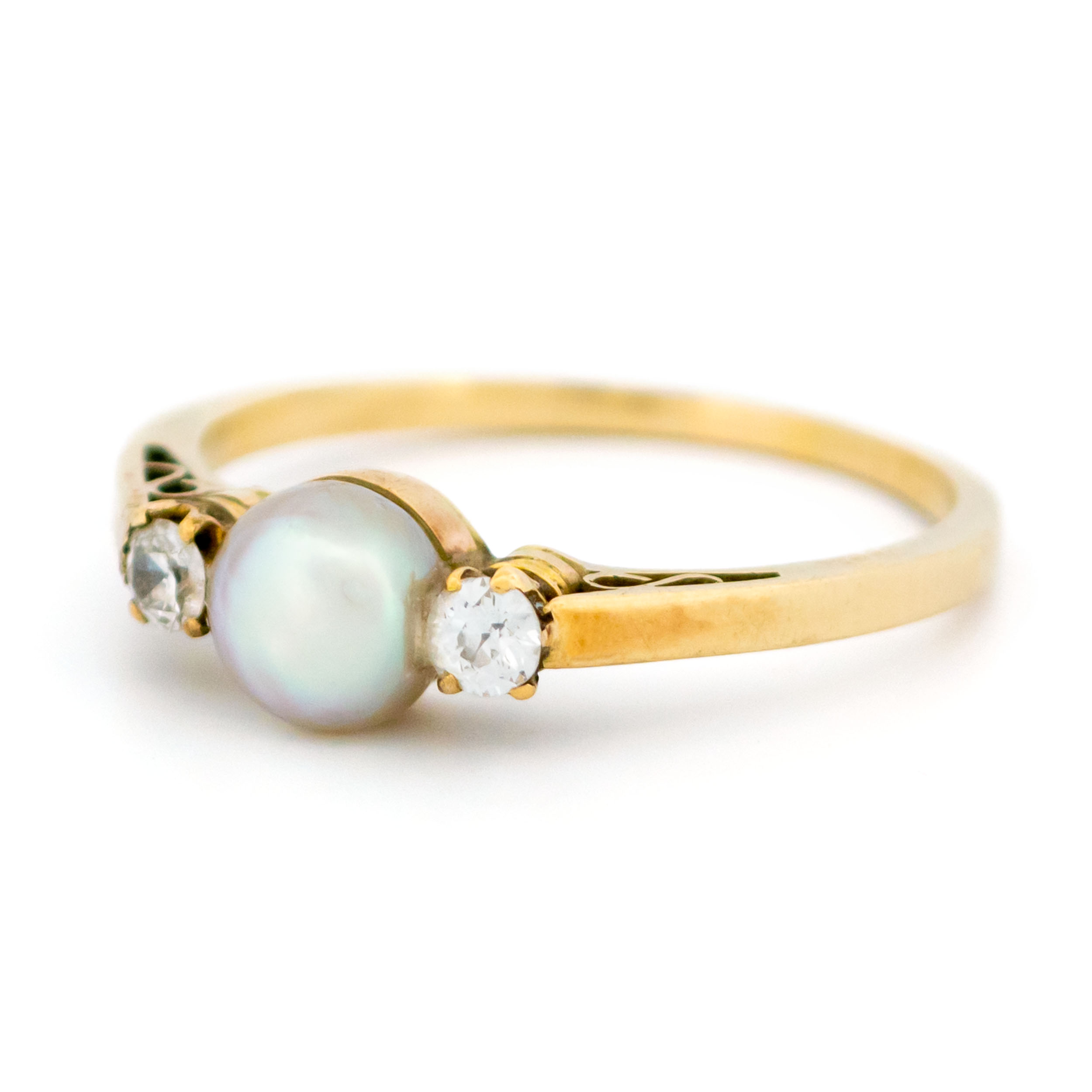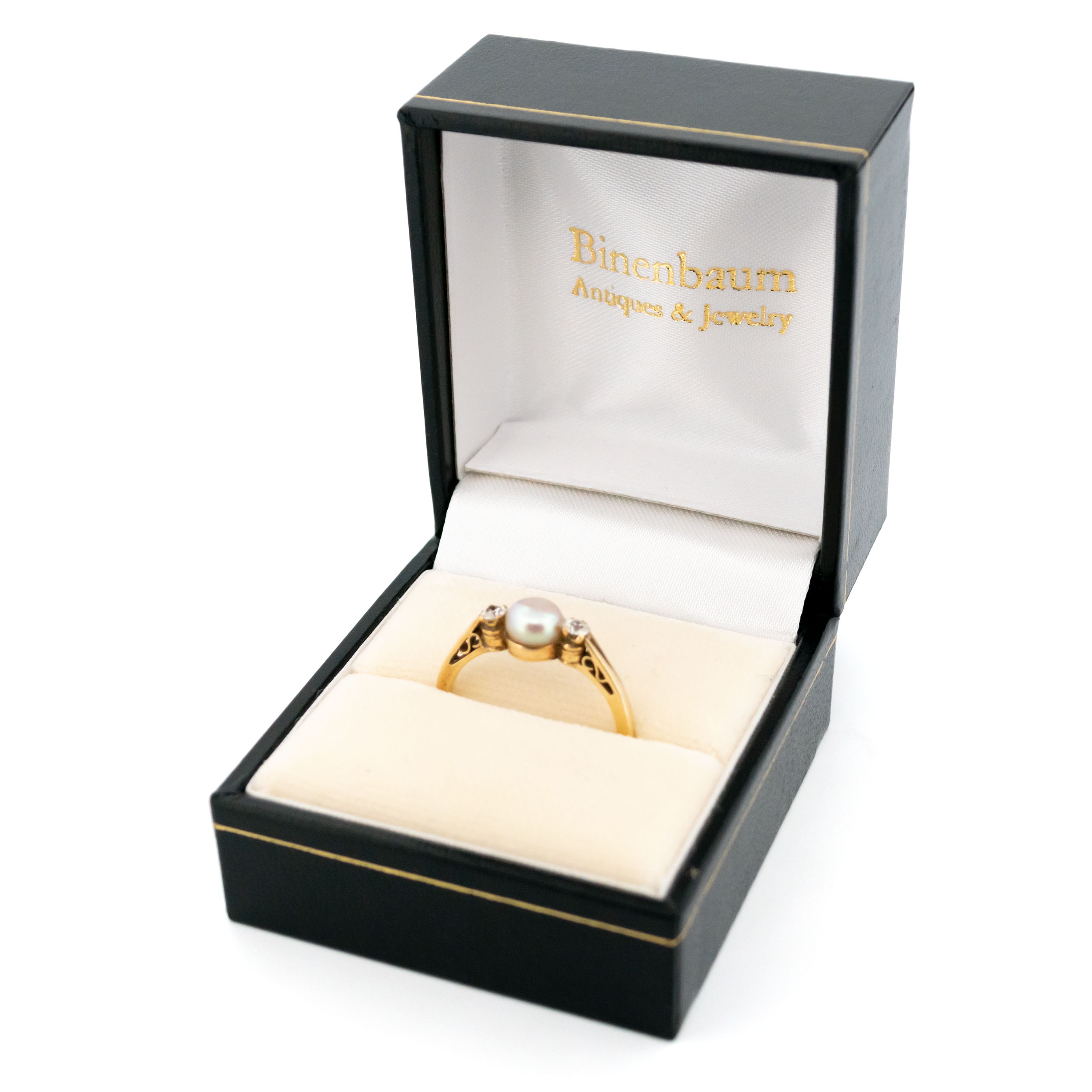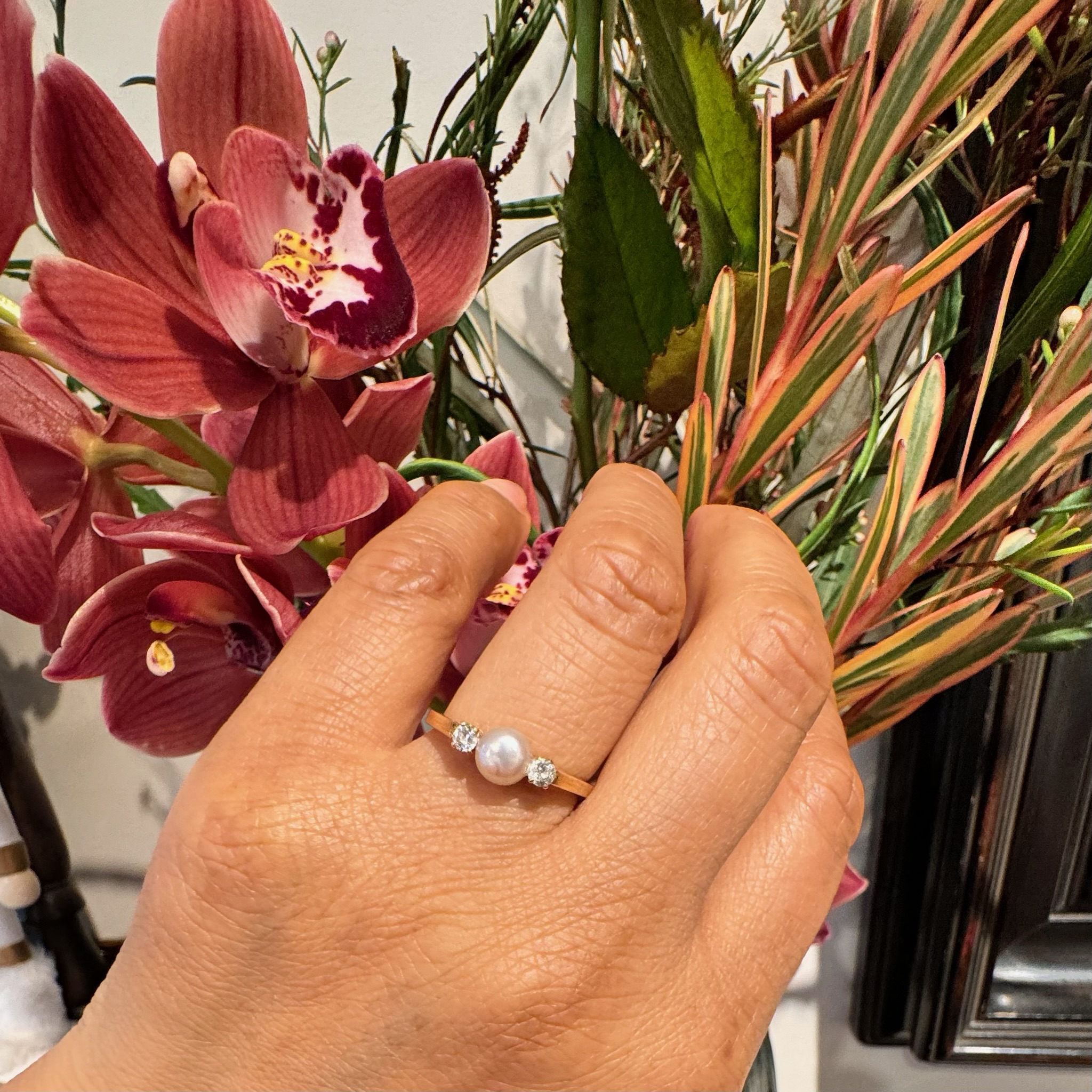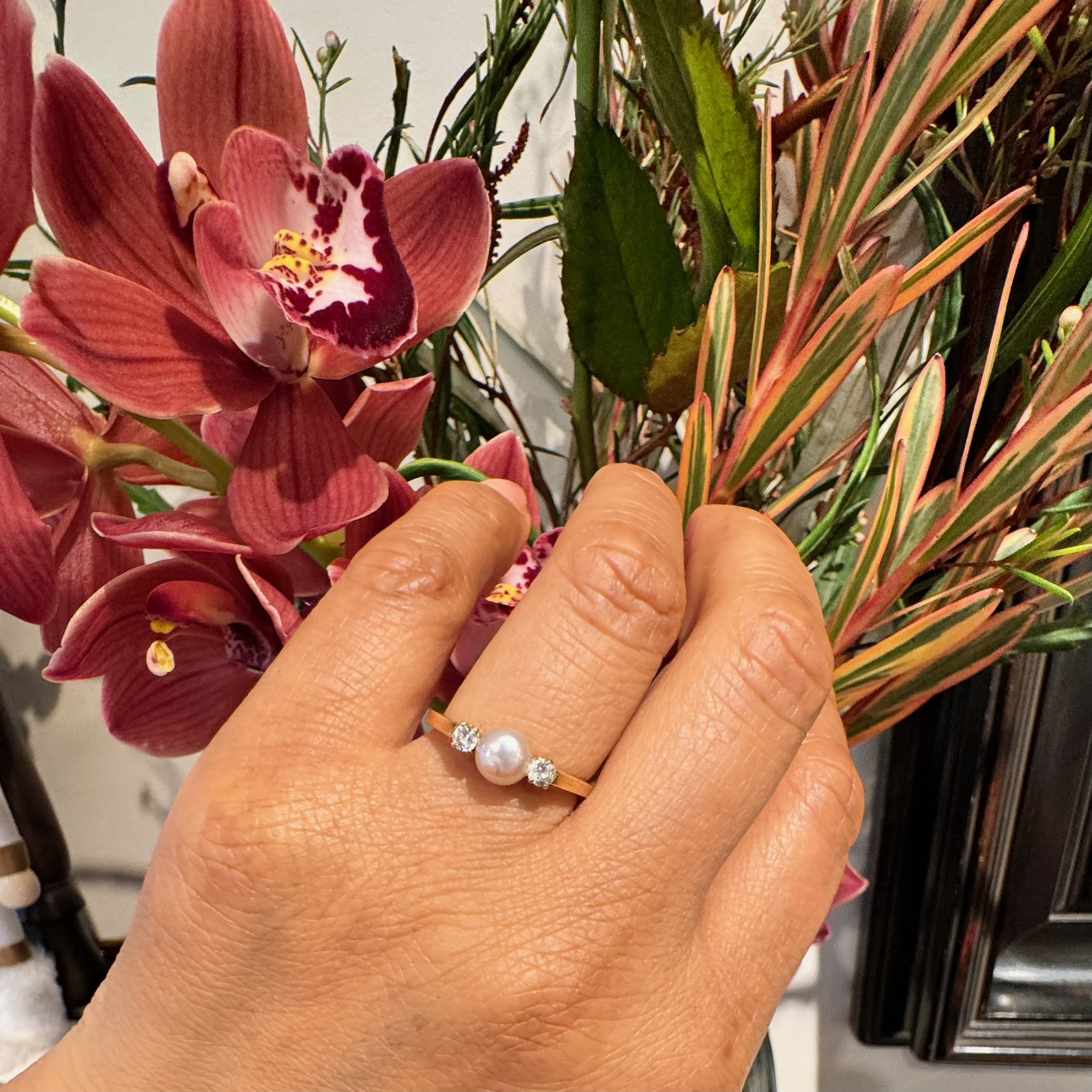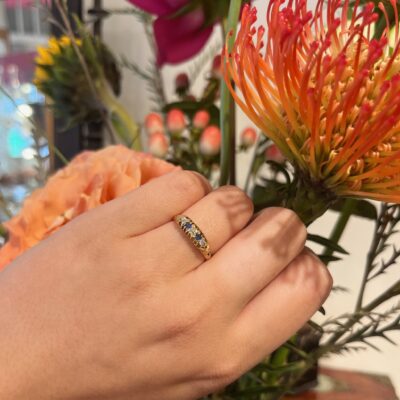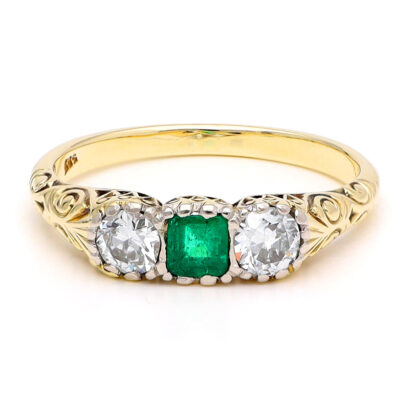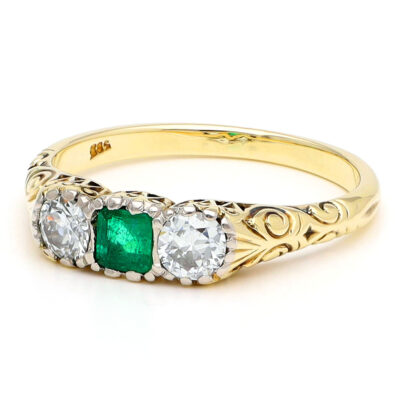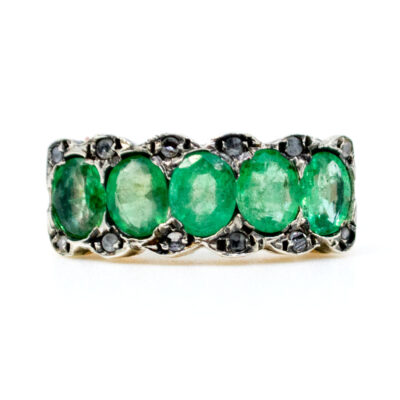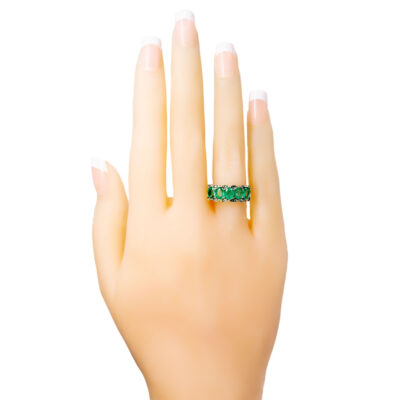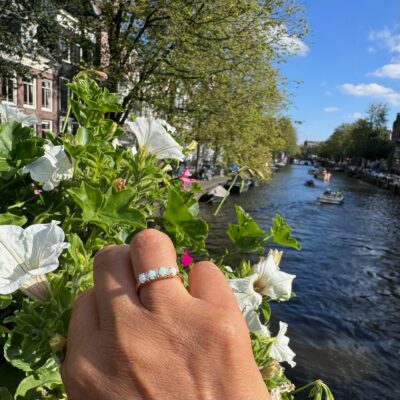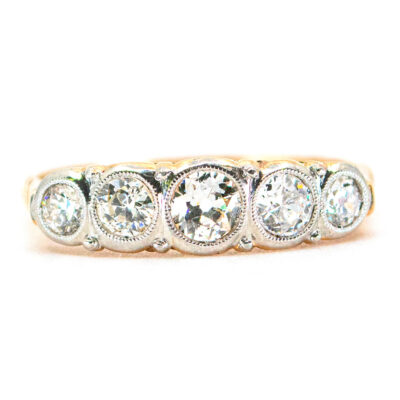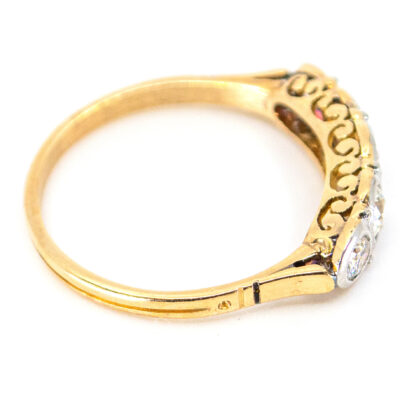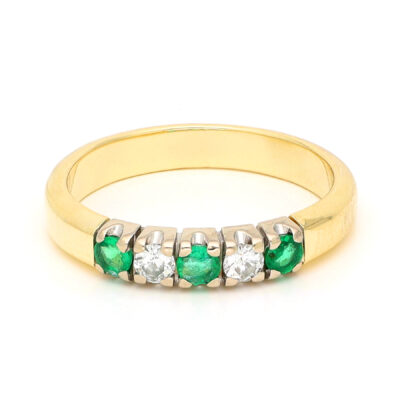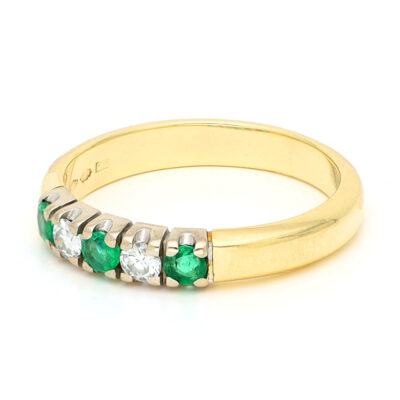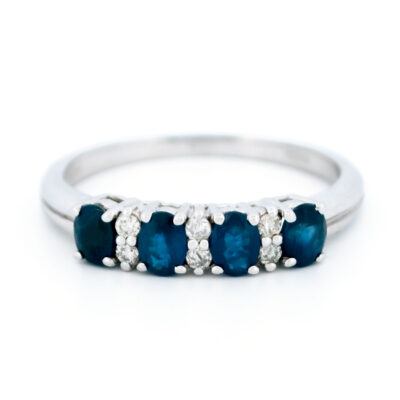Indulge in the vintage allure of our Late-Victorian Pearl and Diamond Row Ring. Crafted in warm yellow 14k gold, this ring features a stunning 6mm orient pearl, complemented by 0.15ct of old-European-cut diamonds (J SI1). A testament to antique elegance and craftsmanship. 🌹✨
Videos
Details: 6mm Orient Pearl, 2 totaling ±0.15ct (J SI1) Old-european-cut diamonds, 9k Ring.
Size: 18.14 NL / 57 FR / 8 US / P½ UK, sizeable (Within reason. Contact seller for information).
Dimensions: H 0.5 x L 1.2 x W 0.6 cm.
Weight in grams: 2.
Condition: Very good condition – slightly used with small signs of wear.
Shipping and Pickup: This pretty piece ships from our store located in the center of Amsterdam, The Netherlands. We offer both registered shipping and local pickup at our store. In the case of local pickup, any applicable shipping costs will be refunded.
About Us: Add some sparkle to your style with Binenbaum.com. We offer a stunning selection of antique and vintage jewelry that you won’t find anywhere else. From timeless rings and dazzling necklaces to unique brooches, we have something for every taste and occasion. Visit our website today and treat yourself to a piece of history.
| Design Era | |
|---|---|
| Design & Historical Context | The Late Victorian or Aesthetic period was a time of great cultural and artistic flourishing in Europe and the United States, and this was reflected in the jewelry of the time. The Aesthetic movement, which emphasized beauty and art for art's sake, was particularly influential on jewelry design during this time. Late Victorian or Aesthetic period jewelry is known for its intricate detailing and use of precious materials such as gold, silver, and diamonds. It often featured motifs such as flowers, animals, and nature scenes, and was inspired by a variety of cultural movements, including the Arts and Crafts movement, which sought to return to traditional craftsmanship and natural materials. One of the most distinctive features of Late Victorian or Aesthetic period jewelry is its emphasis on the use of enamel. Enamel is a type of glass-like material that is fused to a metal surface, and it was often used to add color and detail to jewelry. The French firm, Cartier, was particularly known for its use of enamel in its Late Victorian or Aesthetic period pieces. Late Victorian or Aesthetic period jewelry remains popular and is highly collectible to this day. It is often associated with the elegance and refinement of the time period, and is often seen as a symbol of wealth and sophistication. |
| Key Materials | |
| Materials & Craftsmanship | Pearl: The Gem of Elegance and Purity Pearls, with their natural luster and timeless beauty, are one of the most revered gemstones in the world. Unlike other gems, pearls are organic, formed within the soft tissue of mollusks like oysters and mussels. Their formation process results in a smooth, round gem with a soft, iridescent glow, often referred to as the pearl essence. Historically, pearls have been a symbol of purity, wisdom, and wealth. In ancient Rome, they were considered the ultimate status symbol, while in ancient China, pearls were believed to protect against fire and dragons. During the Renaissance, pearls were so highly valued that they were reserved for royalty and nobility, symbolizing perfection and integrity. In modern jewelry, pearls are cherished for their classic elegance and versatility. They are commonly found in a range of colors, from the traditional white and cream to rare black, pink, and golden hues. Pearls are often strung into necklaces, set into earrings, or used as delicate accents in rings and bracelets. Their softness, with a Mohs hardness of 2.5 to 4.5, requires gentle care, but their beauty and sophistication are unmatched. Pearls are more than just a gem; they are a symbol of grace, purity, and timeless style. Their natural origins and understated elegance make them a beloved choice for jewelry that exudes refinement and sophistication. Old-european-cut diamond: The Vintage Sparkle of Classic Romance Old European-cut diamonds are a beloved choice for those who appreciate vintage elegance and timeless beauty. This diamond cut, which was predominant from the late 19th century through the early 20th century, is known for its round shape, high crown, small table, and large, open culet. These characteristics give the stone a soft, romantic sparkle that evokes the charm of a bygone era. Historically, the Old European cut was the precursor to the modern round brilliant cut. It was crafted by hand, with each facet carefully shaped to maximize the diamond's brilliance under the softer lighting conditions of the time, such as candlelight. This cut was popular during the Victorian, Edwardian, and Art Deco periods, making it a favorite in antique and vintage jewelry. In modern jewelry, Old European-cut diamonds are highly sought after for their unique sparkle and historical significance. They often exhibit a warmer, more subdued brilliance compared to modern cuts, with an emphasis on depth and fire rather than the bright flashes of light seen in contemporary diamonds. This makes them ideal for engagement rings, earrings, and other pieces that celebrate vintage style and craftsmanship. An Old European-cut diamond is more than just a gemstone; it is a piece of history, reflecting the elegance and romance of the past. Its distinctive charm and enduring beauty make it a perfect choice for those who appreciate the artistry and nostalgia of vintage jewelry. 9k: The Affordable and Durable Choice with a Subtle Golden Hue 9k gold is a cost-effective and sturdy option in the world of fine jewelry, particularly popular for those seeking the look of gold at a more accessible price point. The 9k indicates that the gold is composed of 37.5% pure gold, with the remaining 62.5% made up of alloyed metals such as copper, silver, nickel, or zinc. This higher proportion of alloyed metals results in a more durable and harder material, making 9k gold an excellent choice for everyday wear. Historically, 9k gold has been favored in regions like the United Kingdom and Australia, where it is legally recognized as gold. It offers a balance between the luxury of gold and the practicality of more affordable metals, making it accessible to a wider range of people. In modern jewelry, 9k gold is appreciated for its durability and subtle color. While its gold content is lower than that of 14k or 18k gold, it still retains a warm, golden hue, though it is slightly paler. The color of 9k gold can vary depending on the metals used in the alloy: Yellow Gold: 9k yellow gold has a softer, more subdued golden color compared to higher karat golds, but it still carries the classic warmth and appeal of gold. White Gold: 9k white gold has a faint golden tint beneath its white finish, which is often enhanced with a rhodium plating to give it a brighter, more silvery appearance. Rose Gold: 9k rose gold, made by adding more copper to the alloy, has a delicate pinkish hue that is slightly more muted than higher karat rose golds but still carries a romantic charm. 9k gold is commonly used in rings, earrings, bracelets, pendants, and other jewelry that is designed for daily wear. Its increased durability means it is less prone to scratching and bending, making it a practical choice for pieces that are worn regularly. 9k gold is more than just an affordable alternative; it is a symbol of practical luxury and everyday elegance. Its durability, combined with its subtle and warm color, makes 9k gold a popular choice for those who want the beauty of gold with the added benefit of strength and affordability. Whether in a simple design or an intricate piece, 9k gold offers a lasting and attractive option for jewelry that can be cherished daily. |
| Size | |
| Dimensions | H 0.5 x L 1.2 x W 0.6 cm |
| Gender | |
| Weight (in grams) | 2 |
| Condition | Very good condition – slightly used with small signs of wear |
By following these tips, you can enjoy your precious jewelry for many years to come.
Related Products
-
Diamond Sapphire 18k Row Ring 16337-8800
€ 1.695,00 VAT incl. (where applicable) -
Diamond Emerald 14k Row Ring 17887-9322
€ 2.495,00 VAT incl. (where applicable) -
Diamond Sapphire 18k Row Ring 17553-9241
€ 3.895,00 VAT incl. (where applicable) -
Diamond Emerald Silver 9k Row Ring 17925-9333
€ 1.395,00 VAT incl. (where applicable) -
Diamond Opal 14k Row Ring 14686-8389
€ 1.495,00 VAT incl. (where applicable) -
Diamond 14k Row Ring 10504-0521
€ 2.995,00 VAT incl. (where applicable) -
Diamond Emerald 14k Row Ring 17847-9302
€ 1.495,00 VAT incl. (where applicable) -
Diamond Sapphire 14k Row Ring 17515-9263
€ 1.995,00 VAT incl. (where applicable)
- Home
- Collection
- Fine Jewelry
- Silver Jewelry
- Silverware
- Boxes
- Candlesticks
- Salt and pepper shakers
- Miniatures
- Salt cellars
- Spoon Set
- Condiments
- Frames
- Napkin Ring
- Spoon
- Oddities
- Cups
- Vases
- Cutlery
- Serving Spoon And Cake Server
- Candlesticks
- Baskets
- Hanukkiah
- Spice Tower
- Yad
- Tea Set
- Sugar Castor
- Napkin Rings
- Wine Bottle Coaster
- Wine Stopper
- Tea Pot
- Jugs
- Rattles
- Hip Flask
- Miscellaneous
- Rings 💍
- About
- Contact
